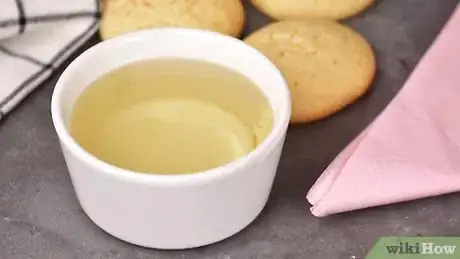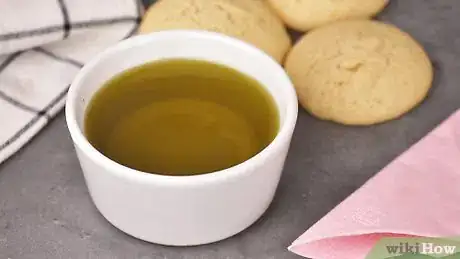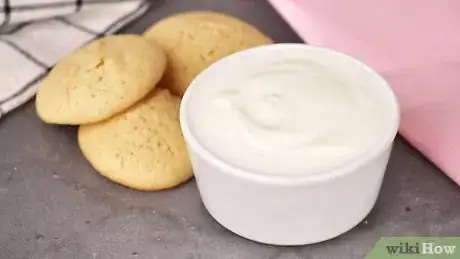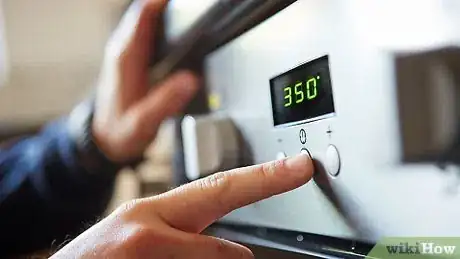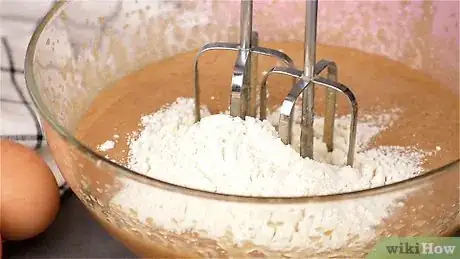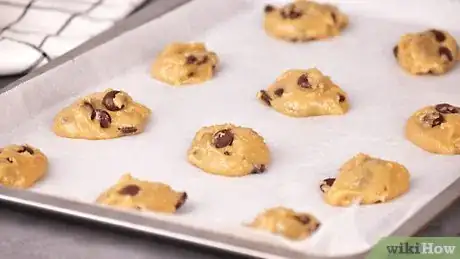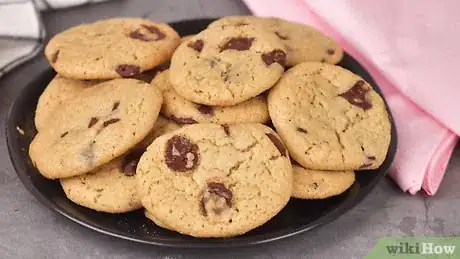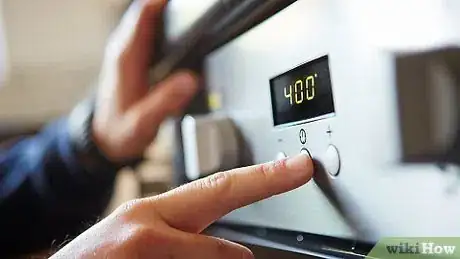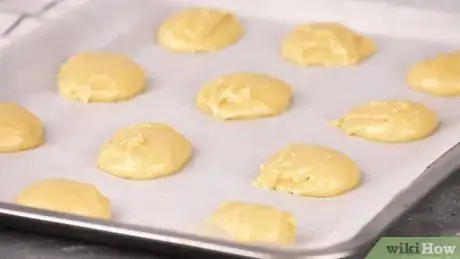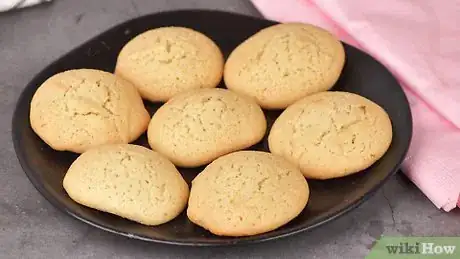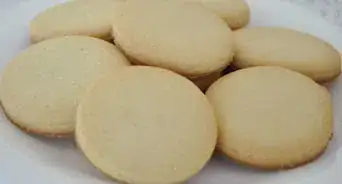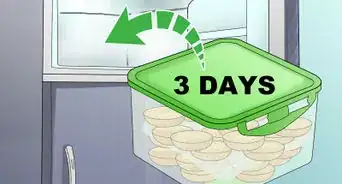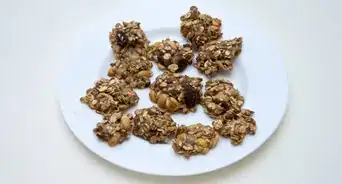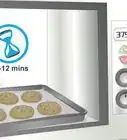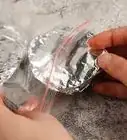This article was co-authored by wikiHow staff writer, Amber Crain. Amber Crain has been a member of wikiHow’s writing staff for the last six years. She graduated from the University of Houston where she majored in Classical Studies and minored in Painting. Before coming to wikiHow, she worked in a variety of industries including marketing, education, and music journalism. She's been a radio DJ for 10+ years and currently DJs a biweekly music program on the award-winning internet radio station DKFM. Her work at wikiHow supports her lifelong passion for learning and her belief that knowledge belongs to anyone who desires to seek it.
There are 14 references cited in this article, which can be found at the bottom of the page.
The wikiHow Culinary Team also followed the article's instructions and verified that they work.
This article has been viewed 14,106 times.
Learn more...
Since cookies are so melt-in-your-mouth delicious, they must have a ton of butter in them, right? Not necessarily! If you want to omit the butter from your favorite cookie recipe, or if you're simply out of butter and need a quick fix, substitute cooking oil for the butter! Cooking oils, like vegetable and coconut oil, contain about the same amount of fat as butter so your cookies will still come out soft and delicious.
Ingredients
- 2 1⁄2 cups (320 g) of flour
- 1 tsp (4.2 g) of baking soda
- 1⁄2 tsp (2.1 g) of baking powder
- 1⁄2 tsp (2.1 g) of salt
- 1 c (240 ml) of vegetable oil
- 1 1⁄2 cups (192 g) of brown sugar
- 1⁄2 cup (64 g) of white granulated sugar
- 2 eggs
- 1 tsp (4.9 ml) of vanilla extract
- 1 tsp (4.9 ml) of almond extract
- 2 cups (256 g) of semi-sweet chocolate chips
Makes 48 cookies
- 2 large eggs
- 2⁄3 c (160 ml) of vegetable oil
- 2 tsp (9.9 ml) of vanilla extract
- 3⁄4 cup (96 g) of white of granulated sugar
- 2 cups (256 g) of all-purpose flour
- 2 tsp (8.4 g) of baking powder
- 1⁄2 tsp (2.1 g) of salt
Makes 24-30 cookies
Steps
General Guidelines for any Recipe
-
1Use vegetable oil as a flavorless replacement in any cookie recipe. Since most people already have vegetable oil in their kitchens, it’s a convenient replacement if you’re out of butter! Vegetable oil also has a neutral flavor, so it won’t influence the taste of your cookies at all. Check the recipe’s butter measurement and use ¾ the amount of oil.[1]
- For example, if your recipe calls for 1 c (240 ml) of butter, use 3⁄4 c (180 ml) of vegetable oil. If the recipe calls for 1⁄2 c (120 ml) of butter, use 3⁄8 c (89 ml) cup or 6 US tbsp (89 ml) of oil.
- Other neutral-flavored options include corn oil and canola oil. Canola oil tends to have the lowest fat content.
-
2Replace butter with coconut oil if you want light, sweet cookies. The flavor of coconut oil pairs well with decadent sweets and can give cookies a light, airy texture. While the flavor is fairly mild, it’s still pretty distinct to most people. If you like the taste of coconut oil, use a 1:1 substitution for butter.[2]
- For example, if your recipe calls for 1 c (240 ml) of butter, use 1 c (240 ml) of coconut oil instead.
Advertisement -
3Try olive oil as a replacement for butter if you’re making savory cookies. Olive oil can be pungent and has a hint of bitterness to it, so it works best in buttery, savory cookies that aren’t super sweet. However, if you enjoy the taste of olive oil, you may not mind the flavor in sweet cookie recipes.[3]
- Use 3⁄4 c (180 ml) of olive oil for every 1 c (240 ml) of butter.
- Tea cakes, biscotti, and gingersnaps are good examples of cookies that are both savory and sweet.
- Olive oil also pairs well with cookies that have a little salt in them, like chocolate chip and peanut butter cookies.
-
4Replace butter with unsweetened applesauce for a low-fat option. Unsweetened applesauce is a healthy butter substitute that won't change the flavor of your recipe. The low fat content does affect texture, though—your cookies will turn out softer and more dense than they normally would. Check the butter measurement in your recipe and replace half of it with applesauce.[4]
- For example, if your recipe calls for 1 c (240 ml) of butter, use 1⁄2 c (120 ml) of applesauce and 1⁄2 c (120 ml) of butter. If you're out of butter or want to omit it completely, substitute the full amount of butter with applesauce.[5]
- Avoid applesauce if you're making crunchy cookies, like shortbread cookies.[6]
-
5Use plain, unsweetened yogurt if you want dense cookies. Yogurt has plenty of fat and moisture, so it's a nice substitute for butter. To create a really dense, chewy texture, go with Greek yogurt instead of regular yogurt. Swap out butter for plain, unsweetened yogurt in a 1:1 ratio.[7]
- For example, if the recipe calls for 1⁄2 c (120 ml) of butter, replace it with 1⁄2 c (120 ml) of yogurt.
- Plain, unsweetened yogurt is rich and flavorful, but it can also be a bit tangy, so keep that in mind.
- Full-fat yogurt works best since you're using it to replace butter. If you want to experiment with low-fat yogurt, keep in mind that the texture might be bit dry or crumbly.
Chocolate Chip Cookies
-
1Preheat your oven to 350 °F (177 °C) and line a baking sheet. Go ahead and preheat your oven so it’s ready to go once you finish mixing the cookie dough. Tear off a piece of parchment paper and place it on your baking sheet to prevent the cookies from sticking.[8]
- Use non-stick cooking spray if you don't have parchment paper on hand.
-
2Combine the dry ingredients in a large bowl. Measure out 2 1⁄2 cups (320 g) of all-purpose flour, 1 teaspoon (4.2 g) of baking soda, 1⁄2 teaspoon (2.1 g) of baking powder, and 1⁄2 teaspoon (2.1 g) of salt and dump each ingredient into a large mixing bowl. Give the ingredients a quick stir to combine them and set this bowl aside.[9]
- Use a spoon to transfer the flour into the measuring cup for the most precise measurements. Avoid dipping the measuring cup into the bag and then leveling off the flour with a knife, which compresses the flour too much.[10]
-
3Cream the oil and sugar together with a spoon or electric mixer. Grab another mixing bowl, measure out 1 c (240 ml) of vegetable oil, and dump it in. Add 1 1⁄2 cups (192 g) of brown sugar and 1⁄2 cup (64 g) of white granulated sugar. Then, blend the ingredients together thoroughly with a spoon or hand mixer.[11]
- If you want to use coconut oil instead, increase the amount by 1⁄4 c (59 ml). You increase it because butter is replaced with 3/4 amount of vegetable oil, whereas coconut oil is a 1:1 substitution for butter.
- To replace vegetable oil with unsweetened applesauce, go with a 1:1 replacement and use 1 c (240 ml) of applesauce.[12]
- For butter-free recipes, an electric hand mixer tends to create a creamier texture. It’s not a deal-breaker if you don’t have one, though! A spoon or spatula will work fine.[13]
-
4Beat the eggs into the mixture 1 at a time. Crack your first egg into the bowl of wet ingredients and mix it in thoroughly. Then, add the second egg and beat it into the mixture until everything is well-mixed.[14]
- For fluffy cookies, let the eggs sit out at room temperature for 30-60 minutes before using them.[15]
-
5Mix the vanilla and almond extracts into the wet ingredients. Measure out 1 tsp (4.9 ml) of vanilla extract and 1 tsp (4.9 ml) of almond extract and add them to the bowl. Use your spoon or electric mixture to blend everything together.[16]
- If you don’t have any almond extract on hand, that’s fine! Omitting it won’t affect the flavor much.
-
6Combine the wet and dry ingredients and mix them together. Add the dry mixture to the wet mixture in small increments, taking care to mix everything well in between each one. This way, the dough is little easier to mix and mixes evenly.[17]
- Mix the ingredients with a wooden spoon or a mixer. If you use a mixer, work carefully so you don't send up puffs of dry ingredients into the air.
-
7Fold the chocolate chips into the cookie dough gently. Measure out 2 cups (256 g) of chocolate chips and dump them in the bowl.[18] Cut through the center of the dough with a spatula to divide it in half. Drag the spatula toward you, scraping the bottom of the bowl and up the side. Lift the spatula up, spin the bowl a quarter turn, and repeat the process to fold in the chocolate chips.[19]
-
8Use a tablespoon to drop individual cookies onto the baking sheet. Scoop up some batter and let the dough drop off your spoon onto the parchment-lined sheet. That’s your first cookie! Continue scooping and dropping dough by the tablespoon, leaving 3 inches (7.6 cm) of space between each cookie so they have room to spread out.[20]
-
9Bake the cookies for 8-9 minutes and let them cool. Slide the baking sheet into the oven. The cookies bake fast, so stay close! They're ready to take out when the look lightly browned around the edges. Let them cool for a few minutes on the baking sheet before transferring them to a wire rack.[23]
- Hot cookies straight out of the oven are still pretty soft and can lose their shape easily. Wait a couple of minutes so they can cool and solidify before transferring them to the wire rack.
- Store leftover cookies in an airtight container at room temperature. Try to gobble them up in 2-3 days!
Sugar Cookies
-
1Preheat your oven to 400 °F (204 °C). Go ahead and start heating up your oven so it’s ready to go once you finish mixing the cookie dough.[24]
-
2Whisk the flour, baking powder, and salt in a medium-sized bowl. Measure out 2 cups (256 g) of all-purpose flour, 2 teaspoons (8.4 g) of baking powder, and 1⁄2 teaspoon (2.1 g) of salt and dump them all into a mixing bowl. Use a whisk or spatula to stir the dry ingredients together evenly. Then, set this bowl aside.[25]
-
3Cream the oil and sugar in a separate bowl with a spoon or mixer. Grab a large mixing bowl. Measure out 2⁄3 c (160 ml) of vegetable oil and 3⁄4 cup (96 g) white of granulated sugar and pour them in the bowl. Use a large wooden spoon or electric hand mixer to mix them together thoroughly.[26]
- If you want to use olive oil, canola oil, or unsweetened applesauce instead of vegetable oil, you don't need to change the measurement at all. Use 2⁄3 c (160 ml).
-
4Beat the eggs and vanilla extract into the oil-sugar mixture. Add the eggs to the large bowl, 1 at a time, beating in between each one. Then, measure out 2 tsp (9.9 ml) of vanilla extract and pour that in. Keep stirring or mixing until all of the ingredients are mixed evenly.[27]
-
5Stir the dry mixture into the wet mixture gradually. Pour about 1/4 of the dry mix into the large bowl of wet ingredients and beat or mix it in. Then, add another 1/4. Keep going until all of the dry mixture is thoroughly mixed into the wet mixture.[28]
-
6Drop the dough by the teaspoon onto the baking sheet. Scoop up a spoonful of dough and drop it on the baking sheet. Keep scooping and dropping, leaving about 3 inches (7.6 cm) between each dough ball so the cookies have room to spread out.[29]
-
7Flatten each cookie with your palm or the bottom of a drinking glass. You don’t need to smash the cookies down super flat! Just press them enough so they have a flat surface. Your palm works fine, or grab a drinking glass and use the bottom to flatten each cookie.[33]
-
8Bake the cookies for 6-10 minutes. Slide the baking sheet into your preheated oven and let the cookies bake. Don’t stray too far since they’ll be ready in just a few minutes. Once the cookies look light golden brown, they’re ready to take out![34]
- Let the cookies cool for a few minutes before you dig in.
- Store leftover cookies in an airtight container at room temperature for 4 days.[35]
Things You'll Need
Chocolate Chip Cookies
- Baking sheet
- Parchment paper
- 2 bowls
- Large spoon
- Electric hand mixer
- Spatula
- Measuring cups and spoons
- Airtight container
Sugar Cookies
- Baking sheet
- 2 bowls
- Large spoon
- Electric hand mixer
- Spatula
- Measuring cups and spoons
- Airtight container
References
- ↑ https://sugarandcharm.com/butter-less-chocolate-chip-cookies
- ↑ https://www.thekitchn.com/butter-substitute-baking-23023173
- ↑ https://foodsguy.com/sugar-cookies-without-butter/
- ↑ https://www.mashed.com/170752/how-to-substitute-applesauce-into-your-recipe/
- ↑ https://www.wideopeneats.com/11-butter-substitute-options/
- ↑ https://www.thekitchn.com/butter-substitute-baking-23023173
- ↑ https://www.thekitchn.com/butter-substitute-baking-23023173
- ↑ https://sugarandcharm.com/butter-less-chocolate-chip-cookies
- ↑ https://www.food.com/recipe/butter-less-chocolate-chip-cookies-478379
- ↑ https://www.foodnetwork.com/fn-dish/recipes/2019/12/best-way-measure-flour-baking-food-network-kitchen-app
- ↑ https://www.food.com/recipe/butter-less-chocolate-chip-cookies-478379
- ↑ https://www.mashed.com/170752/how-to-substitute-applesauce-into-your-recipe/
- ↑ https://breaddad.com/no-butter-chocolate-chip-cookies-vegetable-oil/
- ↑ https://sugarandcharm.com/butter-less-chocolate-chip-cookies
- ↑ https://www.southernliving.com/kitchen-assistant/should-eggs-be-room-temperature-baking-cookies
- ↑ https://www.food.com/recipe/butter-less-chocolate-chip-cookies-478379
- ↑ https://sugarandcharm.com/butter-less-chocolate-chip-cookies
- ↑ https://www.food.com/recipe/butter-less-chocolate-chip-cookies-478379
- ↑ https://www.cooksillustrated.com/how_tos/5570-baking-basics-folding
- ↑ https://sugarandcharm.com/butter-less-chocolate-chip-cookies
- ↑ https://breaddad.com/no-butter-chocolate-chip-cookies-vegetable-oil/
- ↑ https://www.epicurious.com/archive/blogs/editor/2014/02/chocolate-chip-cookie-baking-tips.html
- ↑ https://www.food.com/recipe/butter-less-chocolate-chip-cookies-478379
- ↑ https://www.food.com/recipe/grandmas-soft-sugar-cookies-11345
- ↑ https://foodsguy.com/sugar-cookies-without-butter/
- ↑ https://foodsguy.com/sugar-cookies-without-butter/
- ↑ https://www.food.com/recipe/grandmas-soft-sugar-cookies-11345
- ↑ https://foodsguy.com/sugar-cookies-without-butter/
- ↑ https://www.food.com/recipe/grandmas-soft-sugar-cookies-11345
- ↑ https://foodsguy.com/sugar-cookies-without-butter/
- ↑ https://sugarandcharm.com/butter-less-chocolate-chip-cookies
- ↑ https://www.businessinsider.com/best-cookie-baking-tips-2014-12
- ↑ https://foodsguy.com/sugar-cookies-without-butter/
- ↑ https://www.food.com/recipe/grandmas-soft-sugar-cookies-11345
- ↑ https://www.thekitchn.com/toasted-sugar-cookies-22902985
